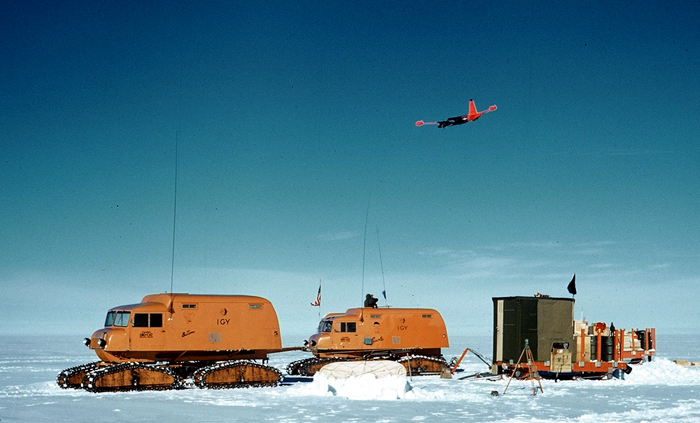|
The fresh PhDBentley has a bit of time to kill, and indulges a curious reporter, who prods him about the danger and excitement that surrounded those pioneering days of the IGY, when dozens of nations committed to a coordinated campaign of peaceful research at the poles, around the world and into outer space. The media hoopla that surrounds such endeavors today didn’t exist in the 1950s. Bentley’s own recounting of how he signed onto an adventure of a lifetime sounds so matter of fact, as if the decision was obvious. Geophysicist Frank Press, who would later become president of the U.S. National Academy of Sciences, popped over one day from a nearby office looking to recruit Columbia University students to take part in the IGY. “He just came across the hall and asked if anyone here wanted to go to the Antarctic,” Bentley recalls. “I thought that sounded like a pretty good idea, so I signed up.” To prepare for the task ahead, Bentley journeyed to Greenland, where with the aid of textbooks, taught himself polar survival skills and collected geophysical data, which he used for his doctoral thesis. The ink not yet dry on his diploma, the 26-year-old flew to Panama to catch up with the U.S. Navy ship carrying scientists to the Ross Sea in 1956. “I was about as fresh a Ph.D. as you could be,” he says. But just about everyone was a rookie, with most of the scientists and Navy personnel supporting the IGY 20-something-year-old men. Bentley says it was rare to meet anyone older than 40 in Antarctica. (Female scientists wouldn’t join the fray on the continent for more than a decade.) Dramatic discoveryIn January 1957, and despite their inexperience, Bentley and a handful of scientists left Little America, a U.S. base located on the edge of the Ross Ice Shelf, for Byrd Station on tracked vehicles called Tucker Sno-Cats®. Along the way, they conducted experiments to gauge the depth of the ice sheet. To their astonishment, they discovered it was as far below sea level as above, meaning they were traveling over a former marine area and not subglacial mountains as everyone had assumed until then. Bentley still calls the discovery the most dramatic of his career. Today the finding is particularly poignant in a global warming scenario. A marine-based ice sheet like the one over West Antarctica is more vulnerable to melting and collapse. Its complete dissolution could raise sea level, according to the most quoted climate models, by six meters, about 20 feet. “It’s a terrible threat,” Bentley says. Wintering at ByrdBut those startling projections were still decades away. The scientists in 1957 were excited about the data they collected. It would keep them busy for much of the approaching winter after they reached Byrd Station. “We had a lot of data to work on at Byrd Station, and that was a major source of entertainment, mainly because of the interesting stuff we were finding out,” Bentley says. That’s a good thing, as other entertainment was scarce. “Well, hardship meant that our pool table didn’t get out there, our ping-pong table didn’t get out there, we were low on brandy and hard liquor, [and] the beer froze. But that’s not hardship. We had plenty to eat, we had good food, we had a warm place to live, we didn’t have to work very hard,” he recalled in an oral history interview with Dian Olson Belanger in her seminal book on the era, Deep Freeze: The United States, the International Geophysical year, and the Origins of Antarctica’s Age of Science (University Press of Colorado, 2006). (See related story in the Oct. 29, 2006 issue of The Antarctic Sun. The young researchers also spent time that winter preparing for their upcoming traverse across the white unknown of West Antarctica. The trail from Little America to Byrd had been marked with flags and 55-gallon drums. No clear road lay ahead for their 1957-58 traverse. “We realized we were going to be on our own, so maybe we should learn how to navigate,” Bentley explains. “So we spent a good part of the winter teaching ourselves celestial navigation.” |



For USAP Participants |
For The Public |
For Researchers and EducatorsContact UsU.S. National Science FoundationOffice of Polar Programs Geosciences Directorate 2415 Eisenhower Avenue, Suite W7100 Alexandria, VA 22314 Sign up for the NSF Office of Polar Programs newsletter and events. Feedback Form |


